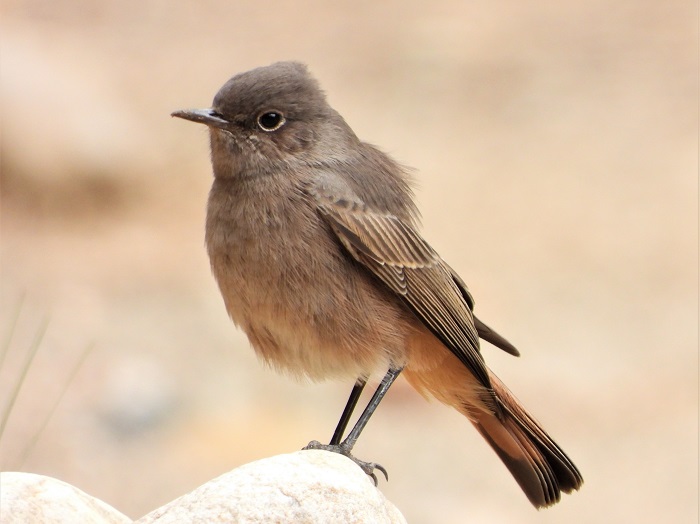Cover image of Familiar Chat by Ryan Tippett – Near Carnarvon, Northern Cape – BirdPix No. 253536
Identification
The Familiar Chat is a small and drab species. The sexes are alike.
The overall colour is greyish-brown and buff. The most distinguishing characteristic is the rufous-orange rump and tail. The centre and tip of the tail is blackish-brown, forming an upside down ‘T’. This is diagnostic and most easily observed in flight. The ear coverts are rufous-brown and the bill, legs and feet are black.

Sani Road, KwaZulu-Natal
Photo by Pamela Kleiman
Juveniles have upper parts spotted buff, while the underparts show dark feather tips, giving a scaled appearance.

This is a young bird, with buff-tipped feathers on the back and spots on the front.
Ezemvelo, Gauteng
Photo by Anthony Paton
Most easily mistaken for the Sickle-winged Chat (Emarginata sinuata) but that species has a pale, rufous-pink (not orange) rump and a broad blackish triangle (not the ‘T’) on the tail.
The Tractrac Chat (Emarginata tractrac) is normally far paler and with a whitish rump and extensive white on the sides of the tail.

Meiringspoort, Western Cape
Photo by Ansie Dee Reis
Status and Distribution
The Familiar Chat is a common resident but may move locally in response to food availability in arid areas.
It has a disjunct distribution in West, Central and East Africa. It is commonest and most widespread in South Africa with the highest population densities occurring in the semi-arid Karoo. It is markedly absent from most of Botswana as the Kalahari sandveld offers few suitable nesting sites.
It is possible that the range of the Familiar Chat has expanded considerably in the semi-arid parts of South Africa and Namibia, due to to the erecting of artificial water points in farming areas. The Familiar Chat is not considered threatened.

Details for map interpretation can be found here.
Habitat
Inhabits rugged mountain slopes, rocky hills and outcrops, valley slopes, eroded gullies, and sparse woodland along drainage lines. The Familiar Chat has a preference for rocky and broken ground in a variety of vegetation types from semi-desert to fynbos and woodland. Has adapted well to farmyards and towns, mostly in rural areas, where it is associated with buildings and rooftops. It is seldom encountered far from water.

Photo by Ryan Tippett
Behaviour

Paarl, Western Cape
Photo by Gerald Gaigher
Although a plain-coloured bird this common species is ‘familiar’ to most observers and is conspicuous in its behaviour. It occurs singly, in pairs or small family parties. Becomes tame around human settlements and picnic sites. Perches on almost any raised object, such as large stones, termite mounds, bare shrubs or trees, fence posts and buildings. Flicks wings constantly (more often than other chats) and, on landing, usually raises its tail once or twice.
Hunts from a perch, diving to the ground to snap up prey and usually returns to the same perch. They are known to associate with Klipspringers Oreotragus oreotragus, taking ectoparasites as well as invertebrates disturbed by the antelope. Also forages in the intertidal zone in the Western Cape, perching on rocks, kelp and other seaweeds. Feeds mainly on invertebrates including spiders, solifuges, millipedes, centipedes, grasshoppers, crickets, bugs, beetles, ants, termites, flies, snails and caterpillars. Also consumes seeds and small fruits as well as scraps from human and pet foods and scavenges from road kills. Formerly ate grease from wagon axles, giving rise to its Afrikaans name ‘Spekvreter’ (fat-eater).

Paarl, Western Cape
Photo by Gerald Gaigher
Breeds during spring and summer, often opportunistically after rain in arid areas. The Familiar Chat is a territorial, solitary nester. The nest is a neat cup, the outside of which is built with soft plant material as well as bits of string and other items found around human dwellings. The nest interior is lined with feathers, wool, fluffy seeds or hair. The nest is opportunistically placed in a recess or cavity of some kind. Typical nest sites include the old burrows of other hole nesting species like bee-eaters, a hole in a rock face or erosion gully, old, partially broken swallow nests and often in man-made sites like under the eaves of roofs, in disused machinery, in pipes and even inside buildings. Both sexes help to construct the nest and building is usually completed in 2 to 13 days. 2 to 4 eggs are laid per clutch and incubation begins after the second egg is laid. Incubation lasts for 13 to 15 days and nestlings are fully fledged after a further 15 days. The young are fed and cared for by both sexes.

Bushmanskloof, Western Cape
Photo by Zenobia van Dyk
Further Resources
Species text adapted from the first Southern African Bird Atlas Project (SABAP1), 1997.
The use of photographs by Ansie Dee Reis, Anthony Paton, Gerald Gaigher, Johan and Estelle van Rooyen, Pamela Kleiman and Zenobia van Dyk is acknowledged.
Virtual Museum (BirdPix > Search VM > By Scientific or Common Name).
Other common names: Gewone spekvreter (Afrikaans); umBexe (Zulu); Unongungu (Xhosa); Traquet familier (French); Rostschwanzschmätzer (German); Roodstaart-spekvreter (Dutch); Chasco-familiar (Portuguese)
Recommended citation format: Tippett RM 2023. Familiar Chat Oenanthe familiaris. Biodiversity and Development Institute. Available online at http://thebdi.org/2023/05/22/familiar-chat-oenanthe-familiaris/
List of bird species in this format is available here.

Near Witsand, Western Cape
Photo by Johan and Estelle van Rooyen

